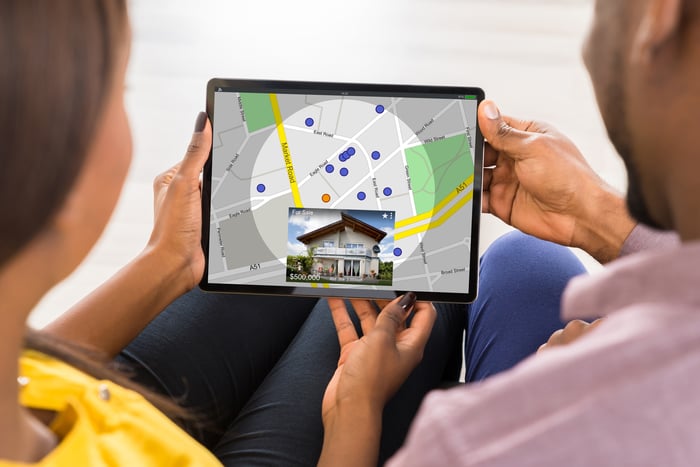Zillow's (ZG 1.90%) (Z 1.96%) rapidly growing iBuying business, Zillow Offers, has taken a big hit this year but is poised to bounce back. How quickly that happens is uncertain, but the company has the resources and expertise to rapidly return the business -- through which it buys and resells houses -- to its prior size and growth trajectory. Here's the situation.
The backstory
Zillow rapidly grew its Zillow Offers iBuying business from its inception in 2018 until recently. Through the end of last year, the company had purchased 7,197 homes in total and had resold 4,490 of them, ending 2019 owning 2,707 homes worth $837 million. And the pace of growth was accelerating at an extraordinary rate. Zillow went from buying 19 homes in the second quarter of 2018 to buying 2,291 homes in the third quarter of last year. This rapid scaling was driven by the unit's expansion into more U.S. markets, as well as greater time and experience in older markets.
In early 2019, the company's management team had put forth three-to-five-year targets for Zillow Offers that included buying 5,000 homes per month. The company appeared to be on pace to achieve that number.

Image source: Getty Images.
Selling its inventory
But everything changed when COVID-19 arrived in the U.S. earlier this year. Economic activity appeared to freeze up, and Zillow saw its overall site traffic go from low double-digit year-over-year growth to 20% year-over-year declines by late March. It was unclear how bad things would get, how many of Zillow's Premier Agent customers would continue paying Zillow for homebuyer leads, and how easily Zillow would be able to resell its inventory of houses. To counter this uncertainty, Zillow froze all hiring, froze most marketing spending, paused homebuying in all markets, and committed to reducing its operating expenses by 25% compared to its 2020 budget.
During the second quarter, Zillow bought just 86 homes and sold 1,437 homes, reducing its ownership to 440 homes. That compares to a peak of owning 2,822 homes in the third quarter of 2019. This rapid reselling of homes created meaningful revenue in the homes segment in the quarter -- $454 million -- because revenue is the proceeds from home sales, but it left the company with a largely depleted number of homes in inventory.
What's next?
That home inventory depletion has set Zillow Offers back to owning a similar number of homes as it owned at the end of 2018. As a result, management's guidance for third-quarter homes segment revenue is only $140 million to $160 million. The midpoint of that guidance represents a 61% revenue decline versus the prior-year quarter. Of course, when Zillow owns far fewer homes, it's going to resell far fewer homes and therefore have far lower revenue.
So how long will it take Zillow Offers to bounce back to its prior scale? It's hard to say, but Zillow began buying homes in select markets again in May and was back to buying homes in all of its 24 Zillow Offers markets by August. The business is established in all these markets and should have the ability to buy homes rapidly.
Despite the COVID-19 pandemic and the U.S. recession, interest in home shopping and moving has never been higher as evidenced by Zillow's monthly unique users reaching a record high of 218 million in the second quarter, up 12% year-over-year. Total visits to Zillow mobile apps and websites grew 14% to 2.5 billion in the quarter. While sellers and buyers are probably less likely to participate in public open houses due to the pandemic, there's been a significant increase in usage of Zillow's digital tools, including 3D virtual tours and in-person self-tours where buyers can unlock Zillow-owned homes with their mobile phones.
Founder and CEO Rich Barton attributed this to pent-up demand for moving, driven in part by the far greater amount of time people are spending at home, which causes a closer look at housing needs and desires. For example, houses with home offices and backyards are in higher demand than usual, Barton said on the company's conference call. Record-low mortgage rates are also making homes much more affordable.
The pandemic also seems likely to increase the number of requests for Zillow to make offers on homes since selling to Zillow provides certainty of price and closing without the COVID-related risks of opening the door to strangers. Even pre-COVID, Zillow received 70,000 requests for offers in the second-quarter of 2019 and ended up buying just 1,500 homes. I expect Zillow to have plenty of homes to choose from going forward.
How quickly Zillow can rebuild its homes inventory depends in part on the company's appetite for homeownership risk in what is still a somewhat uncertain macroeconomic environment, but with $3.5 billion of cash and short-term investments on the books, Zillow is incredibly well-capitalized and has the firepower to buy a tremendous number of homes. That's why investors should consider the Zillow Offers inventory setback a temporary speed bump on its three-to-five year path toward buying 5,000 homes per month. Between that and the remarkable recovery in Zillow's core business, there's a lot to like about Zillow these days.





